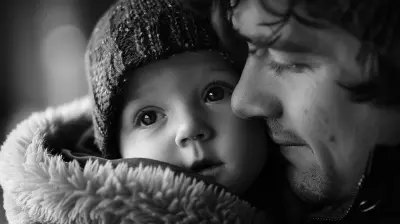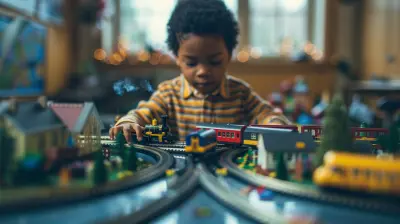Teaching Your Child How to Turn Ideas into Creative Projects
4 July 2025
Creativity is like a muscle—the more you use it, the stronger it gets! As parents, we all want our children to dream big and think outside the box. But turning those amazing ideas into real, tangible projects? That’s a whole different ball game!
If your little one is bursting with imagination but struggles to bring their ideas to life, don’t worry. You’re about to learn how to guide them through the exciting journey of turning thoughts into action—and having loads of fun along the way!

Why Creativity Matters for Kids
Before we jump into the "how," let’s talk about the "why." Creativity isn’t just about arts and crafts; it's a powerful skill that helps kids solve problems, express themselves, and build confidence. When children learn to transform their thoughts into projects, they develop essential life skills like:- Critical thinking – Learning to assess what will work and what won’t.
- Problem-solving – Finding creative solutions to obstacles.
- Perseverance – Understanding that failure is part of the process.
- Self-expression – Using their unique voice to create something meaningful.
Now that we know why creativity is important, let’s explore how we can help our kids bring their ideas to life!

1. Encourage Brainstorming Sessions
Big ideas start with small conversations. Set aside time for fun brainstorming sessions where your child can let their creativity run wild. Use a "no bad ideas" rule to create a safe space where every thought is welcomed.Tips to Make Brainstorming Fun:
- Keep a "Creative Idea Journal" where they can jot down thoughts.- Use sticky notes to write ideas and stick them on a "Creativity Board."
- Play games like "What if?" where you ask fun questions like, _"What if animals could talk? What kind of business would they start?"_
Giving kids a way to capture their ideas prevents them from being forgotten and encourages their creative flow.

2. Help Them Develop an Action Plan
Once your child has an exciting idea, the next step is figuring out how to make it happen! This is where an action plan comes in handy.How to Break It Down:
1. Define the project – What is their idea? What do they want to achieve?2. List the materials needed – Will they need art supplies, building materials, or a computer program?
3. Create a step-by-step roadmap – What needs to happen first, second, and third?
4. Set deadlines – If it's a long-term project, setting small deadlines helps them stay on track.
For younger kids, a simple drawing of the process can help them visualize their plan in a fun way!

3. Teach Them to Embrace Trial and Error
Creativity isn’t about getting it right the first time—it's about trying, failing, and learning. Some kids get frustrated when things don’t go as planned, so teaching them that mistakes are part of the process is crucial.Ways to Encourage a Growth Mindset:
- Share stories of famous inventors who failed before they succeeded (like Thomas Edison and the lightbulb!).- Celebrate "failures" as learning experiences rather than disappointments.
- Encourage them to ask, _"What can we do differently next time?"_
The goal isn’t perfection—it’s progress!
4. Provide the Right Tools and Resources
Imagine trying to bake a cake without flour or eggs. Pretty frustrating, right? The same applies to creative projects! Having the right tools makes a huge difference.Depending on their interests, some useful supplies could be:
- Art Supplies – Paints, markers, colored paper, glue, glitter (because everything's better with glitter!).
- Building Materials – LEGO sets, cardboard, tape, craft sticks.
- Digital Tools – Kid-friendly coding programs, graphic design apps, or animation software.
- DIY Kits – Science experiment kits, jewelry-making sets, or robotics kits.
Having access to a variety of materials encourages children to experiment and explore new creative outlets.
5. Be Their Biggest Cheerleader
Every child needs encouragement, especially when tackling something new. Support them by showing genuine interest in their projects and asking questions about their process.How to Show Encouragement:
- Praise effort, not just results – _"Wow! I love how you kept trying different ways to build that tower!"_- Ask open-ended questions – _"What inspired you to create this?"_
- Participate if they ask for help – But let them take the lead!
Your enthusiasm fuels their confidence to keep creating.
6. Encourage Sharing and Collaboration
Creativity thrives when it's shared! Encourage your child to show their work to family and friends or even collaborate with siblings or classmates.Ideas for Sharing:
- Host a mini art gallery at home for their drawings and crafts.- Create a YouTube channel or blog for their creative projects.
- Enter school or community competitions where they can showcase their talents.
- Encourage group projects, like building a model city with friends or writing a comic book together.
Collaboration teaches kids teamwork, communication, and the joy of bringing ideas to life with others.
7. Lead by Example
Kids model what they see, so if they notice you taking on creative projects, they’ll be more inspired to do the same!What You Can Do:
- Share your own creative hobbies with them—whether it's painting, gardening, woodworking, or writing.- Let them "help" you with DIY home projects.
- Talk about your creative process and challenges.
When they see you dive into creative projects, they’ll feel more encouraged to do the same.
8. Celebrate Their Accomplishments
Finally, every great project deserves a celebration! Whether big or small, acknowledging milestones and finished projects builds confidence and motivation.Fun Ways to Celebrate:
- Throw a "Project Showcase Party" where they present their work.- Create a "Creative Hall of Fame" wall at home to display their projects.
- Share their work on social media (with their permission!).
- Let them teach others how they made it—kids love being the "expert"!
Recognizing their hard work and creativity will only fuel their passion for more projects in the future.
Final Thoughts
Teaching your child how to turn ideas into creative projects is one of the best gifts you can give them. It nurtures problem-solving skills, builds confidence, and fosters a love for innovation that will serve them well in life.So the next time your little one shares a wild and wacky idea, don’t dismiss it. Instead, help them turn that spark into something real—and watch their creativity take flight!
all images in this post were generated using AI tools
Category:
Encouraging CreativityAuthor:

Noah Sawyer
Discussion
rate this article
2 comments
Alexander Stevens
Love this! Inspiring ways to spark creativity in kids!
November 6, 2025 at 4:55 AM

Noah Sawyer
Thank you! I'm glad you found it inspiring!✨
Heidi McAdoo
Encouraging creativity in children fosters problem-solving skills and self-expression, empowering them to explore and realize their unique ideas.
July 15, 2025 at 2:56 PM

Noah Sawyer
Absolutely! Encouraging creativity in children not only enhances their problem-solving abilities but also helps them express themselves and bring their unique ideas to life.


